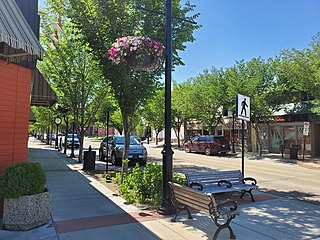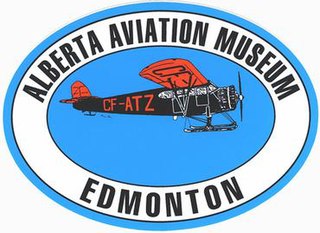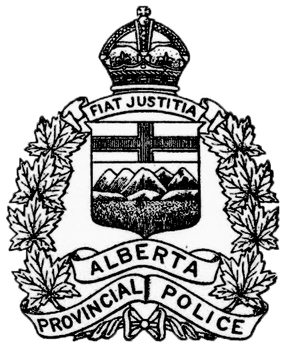
The Royal Canadian Mounted Police is the national police service of Canada. The RCMP is an agency of the Government of Canada; it also provides police services under contract to 11 provinces and territories, over 150 municipalities, and 600 Indigenous communities. The RCMP is commonly known as the Mounties in English.

Edmonton is the capital city of the Canadian province of Alberta. Edmonton is situated on the North Saskatchewan River and is the centre of the Edmonton Metropolitan Region, which is surrounded by Alberta's central region. The city anchors the northern end of what Statistics Canada defines as the "Calgary–Edmonton Corridor", a region spanning between Edmonton and the city of Calgary, Alberta's largest city, which includes the many smaller municipalities between the two.

Fort Saskatchewan is a city along the North Saskatchewan River in Alberta, Canada. It is 25 kilometres (16 mi) northeast of Edmonton, the provincial capital. It is part of the Edmonton census metropolitan area and one of 24 municipalities that constitute the Edmonton Metropolitan Region Board. Its population in the 2021 federal census was 27,464.
The Southern Alberta Institute of Technology (SAIT) is a polytechnic institute in Calgary, Alberta, Canada. SAIT offers more than 110 career programs in technology, trades and business. Established in 1916, it is Calgary's second oldest post-secondary institution and Canada's first publicly funded technical institute.

Fort Calgary was a North-West Mounted Police outpost at the confluence of the Bow and Elbow rivers in present-day Calgary, Alberta, Canada. Originally named Fort Brisebois, after the outpost's first commander, the outpost was renamed Fort Calgary in June 1876.

RCMP Academy, Depot Division is the police training academy for Royal Canadian Mounted Police (RCMP) cadets. Providing training since its establishment in 1885, the facility is located in the west part of Regina, Saskatchewan, near the airport, and consists of several buildings.

The Correctional Service of Canada, also known as Correctional Service Canada or Corrections Canada, is the Canadian federal government agency responsible for the incarceration and rehabilitation of convicted criminal offenders sentenced to two years or more. The agency has its headquarters in Ottawa, Ontario.

Mewata Armoury is a Canadian Forces reserve armoury in Calgary, Alberta, Canada. Mewata ( is derived from the Cree word ᒥᔭᐋᐧᑕᒼ, meaning "Oh, be joyful".

3rd Canadian Division Support Base Edmonton, formerly known as and commonly referred to as CFB Edmonton is a Canadian Forces base in Sturgeon County adjacent to the City of Edmonton in Alberta, Canada. It is also known as Edmonton Garrison or "Steele Barracks".

Government House is the former official residence of the lieutenant governors of Alberta. Located in Edmonton's Glenora neighbourhood, since 1964 the restored and repurposed building has been used by the Alberta provincial government for ceremonial events, conferences, and some official meetings of the caucus.
Wabasca, also known as Wabasca-Desmarais, is a hamlet in northern Alberta, Canada within the Municipal District (MD) of Opportunity No. 17. It is located between and along the South and North Wabasca Lakes, at the intersection of Highway 813 and Highway 754. It is approximately 123 km (76 mi) northeast of Slave Lake.

Downtown Edmonton is the central business district of Edmonton, Alberta. Located at the geographical centre of the city, the downtown area is bounded by 109 Street to the west, 105 Avenue to the north, 97 Street to the east, 97 Avenue and Rossdale Road to the south, and the North Saskatchewan River to the southeast.

The Alberta Aviation Museum is an aviation museum located in Edmonton, Alberta, Canada. The museum is located on-site at the former Edmonton City Centre Airport on the southwest corner of the field.
Canadian Forces Base London is a former Canadian Forces Base that was located in London, Ontario, Canada. It was downsized and closed during defence budget cutbacks in the 1990s. Local Primary Reserve units were supported by Area Support Unit (ASU) London which was located in some of the remaining base buildings, but they are now supported by ASU Toronto. Much of this support is delivered by a Technical Services Platoon which remains stationed in London.
Heritage buildings in Edmonton, as elsewhere in Canada, may be designated by any of the three levels of government: the Government of Canada, the Government of Alberta, or the City of Edmonton.

The Alberta Sheriffs Branch is a provincial law enforcement agency overseen by the Ministry of Public Safety and Emergency Services of the province of Alberta, Canada. Under the authority of the Peace Officer Act, Alberta Sheriffs are provincial peace officers with jurisdiction over the province of Alberta. The premier of Alberta has the authority to grant emergency police powers to all Alberta sheriffs during major emergencies within the province. The Alberta Sheriffs Branch is the largest sheriff service in Canada.

The Alberta Provincial Police (APP) was the provincial police service for the province of Alberta, Canada, from 1917 to 1932. The APP was formed as a result of the Royal North-West Mounted Police (RNWMP) leaving the prairie provinces during the First World War due to a lack of sufficient resources in light of its increased responsibilities for national security and reluctance to again enforce Prohibition law recently put into effect by the Alberta government after its experience doing so during territorial times. The RNWMP was replaced by the newly created Alberta Provincial Police on March 1, 1917, which remained responsible for provincial policing until 1932, when it was eliminated as a cost-cutting measure during the Great Depression. The APP was known for its tumultuous beginning, battles against rum-runners and bootleggers during prohibition in Canada and the United States, as well as its remarkable efficiency and professionalism which endeared the force to Albertans.

Calgary City Hall, is the seat of government for Calgary City Council, located in the city's downtown core of Calgary, Alberta, Canada. The historic building completed in 1911 serves as the offices for Calgary City Council, consisting of the office of the Mayor, fourteen Councillors and municipal Clerk. Calgary City Hall originally housed the municipal council and portions of administration from its completion in 1911 until the construction of the Calgary Municipal Building adjacent to Old City Hall in 1985, which currently houses the offices of 2,000 civic administrators.
The Edmonton Remand Centre (ERC) is a correctional facility in Goodridge Corners, Edmonton, Alberta, Canada. The facility is operated by the Ministry of Justice and Solicitor General of Alberta. The original correctional facility originally opened in 1979. After overcrowding and additional bed space required a second facility was proposed and completed in 2012. The new facility named the New Edmonton Remand Centre (NERC) opened on April 12, 2013, and is currently Canada's largest prison.
















